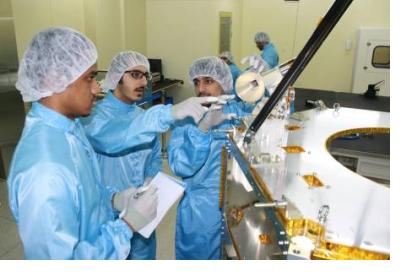DUBAI // The eagle eyes of the DubaiSat-2 can spot travelling cars, make out details on buildings and read logos on aircraft waiting on runways, all the way from outer space.
The latest technology will produce images with much greater clarity than its predecessor, DubaiSat-1, and with much more frequency, its designers announced yesterday.
Emirati engineers have completed the design for DubaiSat-2 at a satellite manufacturing plant in South Korea and are working on a flight model for the launch, which is expected at the end of next year from Russia.
The second remote sensing and imaging satellite from the Emirates Institution for Advanced Science & Technology (EIAST) will have greater resolution, will gather more information from larger areas of the Earth and will download the data more than five times faster than its predecessor, DubaiSat-1.
The image resolution will be similar to what is found on Google Earth, officials said.
Those images are often months or years old, while DubaiSat-2 can provide fresh images each orbit, or several times a day.
Officials stressed that while the technical improvements will produce higher-quality images to be used for everything from urban planning to disaster recovery, there will still be a market for DubaiSat-1's wider but less-detailed images. Having two satellites in orbit will also provide a continuity of data, they said.
EIAST has contracts with municipalities and universities, as well as governments and research institutions in South America, Asia and Europe.
Its images have been useful to international authorities in disaster recovery after Pakistan's floods, and Japan's tsunami and nuclear crises.The satellite images have also been used locally to monitor shoreline erosion and the effects of harmful algal blooms.
"Although this will have better performance, the market will always be there for different resolutions depending on the purpose," said Amer al Sayegh, one of the leading engineers on the project. "The two satellites will be in different areas at different times, and sometimes the same area at the same time, providing more coverage and faster delivery."
While only about 30 per cent of the previous satellite was built by Emiratis, UAE engineers are responsible for about half of the DubaiSat-2's design and manufacturing, with South Korean company Satrec1 helping with the rest.
The new satellite will weigh a third more than its predecessor at 300kg, and will have a resolution of one metre, compared with 2.5 metres for the earlier version. It will orbit closer to the Earth at a faster speed and cover 17,000 square metres per day, more than the 12,000 metres covered by DubaiSat-1.
DubaiSat-2 will also provide single-pass stereo images from different angles, useful for showing the dimension of high-rise buildings or mountainous areas.
"It will be one of the best-performing satellites in space," said Salem al Marri, the director of EIAST's space programme department. "While DubaiSat-1's technology was based on an existing design, this is the UAE's intellectual property that will be useful for future satellites."
DubaiSat-2 will be launched at the end of next year from Yasny Cosmodrome in northern Russia by Moscow-based International Space Company Kosmotras.
Although officials would not disclose the cost of the satellite, they said it would be less than the total US$50 million (Dh183.6 million) spent for the DubaiSat-1 programme.
DubaiSat-2 is expected to orbit in space for as long as eight years.
The UAE has been investing in space and satellite technology as it looks to shift away from an oil-based economy.
The country holds a large stake in Virgin Galactic, the world's first commercial space flight firm. In Abu Dhabi, under another Emirati-run programme, Yahsat launched its first telecommunications satellite last month.
The local industry has taken great pains to guide fresh local talent into the burgeoning sector. EIAST officials said that the involvement of Emiratis in developing DubaiSat-2 had doubled from the first project, with 16 UAE engineers contributing to the development of the satellite at the plant in Daejeon, South Korea.
By the time a fourth satellite is developed - EIAST has already started on the specifications for DubaiSat-3 - it will fully use the skills of Emiratis, said Ahmed al Mansoori, the director general of EIAST.
"While the first satellite was for knowledge transfer, this second satellite will be looked at as more of a commercial [venture]," Mr al Mansoori said. "We will see the range of clients increase to more international municipalities and universities, as well as United Nations projects for natural disasters."

